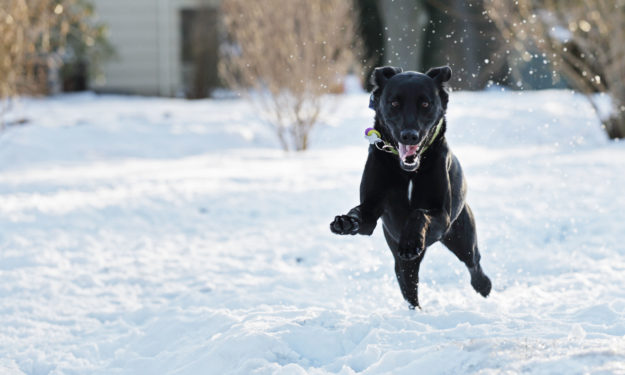Protecting Your Dog’s Paws in Winter Weather

Winter can bring a variety of weather conditions – but that does not mean you and your dog need to stay inside! While there are some things to keep in mind when your dog goes out in the winter, there are plenty of options to keep your pooch happy and healthy when trudging through the cold, snow, and ice!
Dog Paw Protection
You may wonder how a dog’s paws can handle such cold temperatures? Dog paws are made of fat (which is insulating) and have a large amount of blood circulation that allows warm blood to flow from the trunk of their body to the paws to help keep them warm. Many dogs could still benefit from having some sort of barrier or protection from the snow and ice, which can become stuck in the fur between the toes and cut their paws.
Dog Boots
If dogs tolerate it, booties offer a nice solution of protection and warmth, and some even have great traction in icy conditions! Now, not all dogs are tolerant of boots on their feet. Sometimes people have to try one boot at a time with lots of treats to distract their dog while they are wearing the boots. Usually once the dog is outside and moving, they forget they are wearing them all together. There are numerous types of boots such as cloth or rubber, hard soled or soft soled, and many are waterproof. You may purchase them at your local pet store so you can try them on your dog to make sure they fit, or there are a variety of online retailers too.
Paw Waxes
There are also paw waxes that are advertised to help prevent snow and ice from building up between the paw pads when applied before the walk. Some of these waxes and creams even claim to help heal or soothe cracked paws and strengthen paw pads (although each dog will respond and heal differently, similar to people who have problems with dry skin in the winter).
Some suggestions include Mushers Secret, Tuf-Foot, Bag Balm, and others. You may need to experiment with different products to see which works for you and your dog. Be sure to check the safety of any product you use on your dog, especially if they lick their paws after application. All of the above waxes are safe in small amounts but seek medical attention if the dog ingests large amounts.
Pad Tough and Tuff N Up are sprays that can be applied to your dog’s paw pads but should not be ingested at all. In addition, if your dog gets groomed, you may ask that they keep the fur around their paws short to try and prevent snow and ice from accumulating.
Ice Melt & Sidewalk Salt
Another danger to be aware of in the winter is the salt that is used to melt ice. Not only is it irritating topically to your dog’s paws and can cause burns, it is poisonous if ingested. Dogs may lick or eat snow that has salt sprinkled on it, drink from melted snow puddles, lick their paws after walking through it, or they may even get into the bag of salt itself. If they do, you may see anywhere from gastrointestinal signs such as drooling, vomiting, or diarrhea to more serious effects like weakness, tremors, and internal electrolyte changes. If you suspect your dog is showing signs of salt toxicity, please contact your veterinarian right away.
What to Look Out For
When walking your dog, if he or she suddenly doesn’t want to walk, check the paws for snow or ice accumulation between toes, any cuts or cracked paw pads, or even irritation from stepping on debris such as salt or other chemicals used in the winter. It is important to listen and pay attention to your dog. If they are shivering, whining, appear anxious, trying to jump into your arms or look for places to burrow, it’s time to head back home. Hypothermia and frostbite are still possible for any dog, from the furry thick-coated dogs to the ones wearing a coat and boots.
When You’re Back Inside
Once back inside, make sure to wipe your dog’s paws to remove any snow or ice, any salt they may have stepped in, or any other toxic chemicals or materials (such as antifreeze) on the sidewalk they may have walked through. This also gives you a chance to examine their paws for signs of injury (cuts or scrapes) or irritation like cracked paw pads. Use a warm wash cloth or even a shallow warm water bath if they tolerate it. And if your dog has short legs, be sure to check their belly, which can also accumulate snow and ice!
Even with all of these options, some dogs still prefer the coziness of staying home! Have a happy winter!
Written by: Rebecca Brockman, DVM, MS